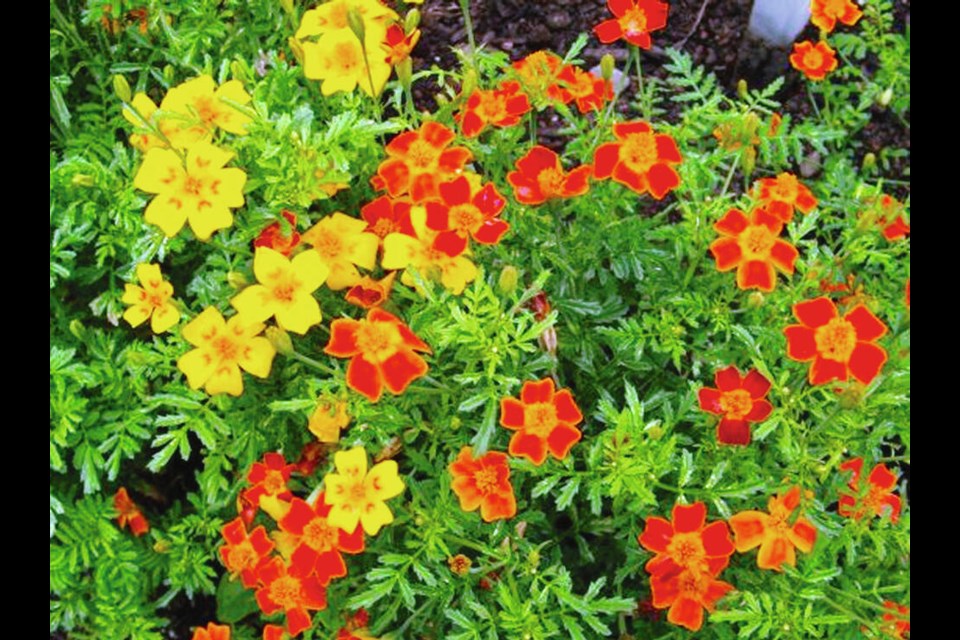As it took form, developed and grew — and grew, and as I monitored its progress, I became increasingly intrigued with the surprising dimensions of this oddity inhabiting my garden.
Throughout the latter part of the summer I became accustomed to hearing the same exclamation from visitors to the garden: “What’s THAT?”
The “That” — the oddity I’d been monitoring — has a name: Lunga di Napoli, which translates to Long of Naples or Neapolitan Long, a centuries-old Italian heirloom winter squash known for its huge size and the sweet, rich flavour and tenderness of the dense orange flesh.
My Lunga di Napoli squash is indeed huge: 84 centimetres long, 16 cm in diameter. It weighs 33 pounds.
A popular squash in southern Italy for centuries, Lunga di Napoli has been considered a treasure for the amount of nutrient-dense food just one squash can provide. The flesh has been prepared and consumed in a multitude of ways: raw in salads, steamed, baked, pureed, grilled, and in soups, pasta dishes, pizzas, pies and breads. The seeds, salted and roasted, are a popular snack.
I kept watch over the unusual squash through the summer, making sure it was raised up above the soil level on improvised props of rocks. I monitored particularly for hardening of the smooth skin, a sure sign that a winter squash has matured sufficiently to store well.
I harvested the squash on Oct. 20. Rain, predicted for the following day, would not be helpful to the maturing process. The stem had turned woody, another good sign of maturity.
It’s been a bit fatiguing staggering about with the colossal squash. First, there was lifting it into a wheelbarrow, then to the kitchen counter for a wipe-down before stumbling back down the stairs to deposit the weighty treasure onto the brick skirting supporting the wood stove.
By late October I had begun to light the stove in the afternoon. The warmth near the stove is about right for the post-harvest “curing” of winter squash and pumpkins. Because the weather remained summer-like through most of October, I had sun-cured earlier harvested squash and pumpkins on trays set next to the south-facing glass door onto the patio.
A week to 10 days in dry warmth helps to further harden the skins and improve the fruits’ ability to store well. After that, all that’s needed is a storage place in a cool room. I use the chilly, north-facing front entry hall of the house.
I won’t be using my giant Lunga di Napoli or other winter squashes for a while. I prefer to allow their flavours to concentrate somewhat before eating them. I anticipate that I’ll begin cutting into my outsized squash shortly before Christmas, so that my son and I can do a little experimenting with the flesh while he is here. Perhaps the traditional Christmas dinner “pumpkin” pie will be a Lunga di Napoli squash pie.
Horticultural adventuring. Whether it’s squash, tomatoes or a favourite flower, it’s worthwhile exploring new vistas each year. I find old, heirloom varieties fascinating, and growing them helps to keep them in circulation and prevent their becoming endangered or extinct. Though I grow newly introduced vegetables and flowers each year, I often find older, time-tested varieties more satisfactory.
An example is the marigold. A new blend out this year put on a nice show before becoming bedraggled in late summer, while I can count on two heirloom marigolds to become increasingly impressive through late summer and early autumn.
Signet marigolds, known also as the “Gem” marigolds, were still flowering merrily in the front garden early this month. Naughty Marietta, the oldest available single-flowered, compact marigold, is equally durable.
GARDEN EVENTS
Glorious grasses. The Hardy Plant Group of the Victoria Horticultural Society will meet Sunday, Nov. 13 from 1:30 to 3:30 p.m. at the Horticulture Centre of the Pacific, 505 Quayle Rd. in Saanich. Mike Rogers will describe his use of ornamental grasses to create an attractive, deer-resistant front garden. Visitor drop-in fee $5.
Peninsula meeting. The Peninsula Garden Club will meet Monday, Nov. 14, at 7 p.m. in the Mary Winspear Centre in Sidney. Club member Deanna Petit-gas will share her experience with cut-flower gardening and farm-stand selling. The evening will include a parlour show, raffle, and access to the expertise of Master Gardeners. Guest fee $5.



